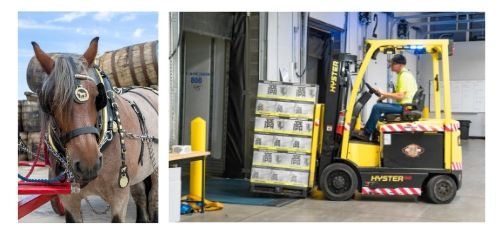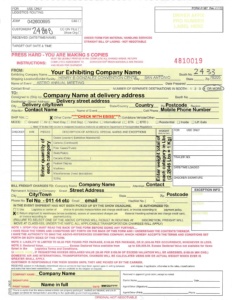Also known as ‘material handling’ drayage is a unique system that you will encounter if you are exhibiting in the U.S. It is an expense that is unfortunately unavoidable, but with a bit of careful planning you can keep your costs as low as possible and reduce the chance of any nasty surprises! Named after the ‘dray’ – the name for the low sided horse-pulled wagon carts of yesteryear (think beautiful Shire horses pulling nostalgic Brewery wagons at summer fetes and festivals), but these have sadly long given way to trucks, computers and modern methods.
So, what is Drayage?
Drayage refers to the movement of your exhibition materials from the delivery vehicle to your exhibition stand space. This service includes: unloading the freight once it has arrived at the receiving dock, transporting the goods to your stand, removing empty shipping items (such as crates and pallets) from your stand space, temporarily storing empty shipping items during the show, returning empty shipping items once the show is over, transferring the freight back to the loading dock, and loading the items onto the vehicle picking up.
A drayage contractor is appointed by the show organiser and your logistics or shipping company do not have any control over the service, or the cost. Costs can vary dramatically between shows – always ensure you read all the small print in your exhibitor pack carefully.
How are Drayage charges calculated?
Drayage fees are based on CWTs (hundredweight) or per 100 pounds. In the US, basic Drayage rates can range between $60 per CWT to about $160 per CWT. The weight is always rounded UP to the next 100lbs in increments. So beware, if your shipment is 110lbs – you will be charged for 200lbs.
To do the actual calculation your load weight is divided by 100, then multiplied by the Drayage rate – this is the cost most people base their show budget costings on – be beware, this is the best-case scenario. A few small changes could have a BIG impact on your actual charged price.
The basic drayage rate is used for freight that meets the following requirements:
• it is not fragile
• it does not have any special handling instructions
• it can be moved easily by a forklift (in other words, it’s on a pallet or crate)
• it arrives at the correct time, and it can be taken directly to your stand space
It is imperative that your load fits within the sizes specified, as oversized loads will also incur additional costs.
Any freight items that do not meet all of these requirements are usually billed at a higher rate – again check your exhibitor information packs for cost details or talk to us and we can make any enquiries on your behalf.
In addition, most trade shows process each loose item separately and have special handling charges. This means that if you are not careful in the way you pack your items, your drayage fees can be raised significantly.
How do you keep your costs as low as possible?
1. Talk to your logistics provider! They are the experts and will be able to give you impartial advice. Remember – they are NOT profiting from the Drayage at all – this is a cost from the show organisers, it is in yours AND your logistics company’s interest to help keep your costs down.
2. Read the small print! Always read your exhibitor pack very carefully, this should contain all the drayage costs information
3. Stick to deadlines. Again, the details will be in your Exhibitor Pack, always ensure you have your bookings done by the deadlines
4. Use an advance warehouse. By shipping your load early to an advance warehouse, nearer to the venue you will be better placed to ensure your load arrives at the venue at the allotted time
5. Ensure your load arrives at the venue loading dock at the correct time. If they need to be moved AFTER the allotted time you will be charged drayage at an overtime rate – sometimes this is double the standard rate.
6. Pack efficiently. Your shipping company will be able to advise the best way to pack your items. Packing items onto pallets carefully, with an eye on the weights and dimensions will ensure you will be charged the least amount possible.
7. Don’t send small items separately. If items are not packed on a pallet and are not too heavy, consider hand carrying them into the venue – uncrated items will incur additional surcharges. Or find a way to pack them onto your pallet.
8. Split loads if necessary. If you have some crated and some uncrated – consider splitting them into 2 shipments and send in under separate bill of ladings. This will avoid the uncrated surcharges applying to your entire mixed load.
End of event Drayage – you’re not quite done yet…
As the docks at the venues are controlled by the drayage contractor, we are unable to come to you stand to pick-up. What you must do at the end of the event is complete a bill of lading (also referred to as a material handling agreement) from the service desk of the drayage contractor. When you have packed, you must complete this form and take it back to the service centre when they’ll check the form and give you a copy.
Without this form being completed, our truck will not be loaded and instead, the Drayage contractor will use whatever methods at whatever cost to return your shipment to you and simply charge it to your credit card. You may incur further costs such as import VAT as the shipment will not be controlled correctly.
We have created an example of a bill of lading / material handling agreement, so you know what is expected. Click on the image below to view it full-size. We do recommend though that you check all of the details with us before completing the form.
Are you considering exhibiting in the U.S. in the future? Why not give us a call to discuss your ideas and we can assist you in planning, shipping and delivery of your exhibition equipment in the safest and most cost-effective way. Our experts are always on hand to offer any advice or alternative suggestions to ensure your exhibition is a success.
UK/EUROPE: Tel: +44 203 780 0666 email: info@ebiss.co.uk
USA: Tel: +1 815 516 5084 email: info@ebiss-usa.com
Exhibitions | Conferences | Art Shipping | Trade Show Asset Management

